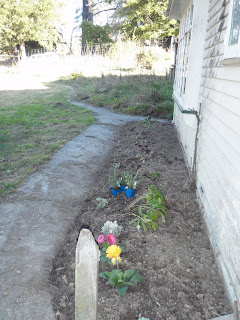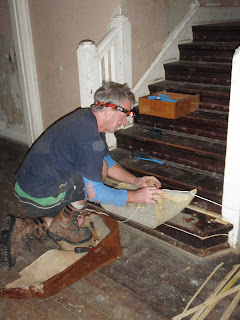The renovation of a large country homestead built in 1912 while improving the surrounding farmland. Starting with the cleaning of the house as it has been abandoned for a couple of years and was left in an extremely poor and filthy condition.
Welcome
Welcome to the Fairlie Funky Farm blog where Nick and Lisa will be describing their adventures renovating Nga Punawai, an old home in Fairlie, South Canterbury, New Zealand.
Saturday, May 22, 2010
Monday, May 17, 2010
There are still plenty of cluster flies around but we are slowly making a difference. Apparently the flies lay their eggs in grass and the hatched larvae feed on earth worms. Once the flies emerge they move in to Nga Punawai (Fairlie Funky farm house) or dark, dry sheltered areas to hibernate for the winter. They release a pheromone to attract other flies, so that makes it even harder to control, as they must have covered this whole house in cluster fly pheromones. Not too happy about them killing the earth worms though, so we are on a mission to destroy them. Someone must have sent a box containing some cluster flies to the Minister of Agriculture in Wellington yesterday, which shut Parliament House down with a bomb scare, possibly got confused with the old 'cluster bomb' in the mail trick.
It is lovely when you open the windows to sweep away the flies and the little fan tails come in for a feed. They aren't shy and hover quite close following you around room to room. If they get stuck they let you know by bobbing up and down impatiently until you open a nearby window. I wanted to take a photo of one but they are never around when I have my camera in hand, only when I have the scrubbing brush!
It is lovely when you open the windows to sweep away the flies and the little fan tails come in for a feed. They aren't shy and hover quite close following you around room to room. If they get stuck they let you know by bobbing up and down impatiently until you open a nearby window. I wanted to take a photo of one but they are never around when I have my camera in hand, only when I have the scrubbing brush!
Monday, May 10, 2010
Sunday, May 9, 2010
There are no tennis courts anymore but we have found where they used to be, a large oak tree is lying across them and would be wonderful to slab up for some furniture. There is not much of an orchard or garden left, but the bare bones are there and I have gathered up some hazelnuts, chestnuts and walnuts to crack open and taste and/or roast. The chooks seem to hang out under the walnut tree, two black, two white and a very proud and hansome rooster. They are wild and even though we have started feeding them, it will be a while until they get used to being fed. There is a chook house but it is full of rubbish and a dead calf....another project to write up on the 'to do' list, so the chooks will be left to roost in the shed roofs until another day.
Wednesday, May 5, 2010
Extract from Canterbury Country Houses - Third Edition, Rodney Wells and Vicky Heward
Nga Punawai
Its Maori name means “ever flowing water”, it was designed by a New Zealand architect influenced by American design and it is made of Australian hardwood. Nga Punawai Homestead is certainly a place where many cultures meet.
The original owner, Henry Le Cren, advertised in the Lyttelton Times for tenders to build a “gentleman’s residence”. In 1912 he commissioned architect Samuel Hurst Seagar to design the house. Mr Seagar had recently returned from America where he had been impressed with the new all white house interiors. Nga Punawai was his first house to feature a low nine foot stud and not to use dark stained panelling, although the original kitchen and maid’s quarters did have dark green walls.
The ever flowing water from which the house gained its name, is a stream that flows through the property and many natural springs found on the land. It is said that Henry would walk from the house to one of these springs to top up his glass of whisky. The grounds had three gardeners to maintain them and a chauffeur was also employed to drive for the Le Cren family. The garage was open-ended with a sweeping drive up to the front door to make the transition from house to car as easy as possible.
The house itself comprised of five bedrooms, all with dressing rooms, an ironing room, a library, living quarters for three maids and in keeping with a “gentleman’s residence”, servant bells in the kitchen. Henry also had a second staircase installed so the maids could go about their work unnoticed. A gas light was also installed at the time the house was built.
Art and culture were important to the Le Cren family. The library featured a collection of French books and Mrs e Cren often placed herself at the top of the stairs to play the violin. The family loved to entertain and Lucy Willis fromSnowden was one of their regular guests.
When Henry died, his widow continued to live at Nga Punawai and was there during the depressions years. Their daughter Ellen then stayed on with the assistance of one maid and parts of the large house were closed down to make the task more manageable. The estate was run by Pyne, Gould and Guinness until 1941.
In 1941 Rupert Josephius Murphy purchased Nga Punawai. He handed it on to his son Jack and his wife. During their time there, the couple had a diesel pump installed (1952) and electricity was connected to the property in 1956.
The Murphys sold Nga Punawai in 1998, leaving behind 346 acres of land and the grand house with its seven acres of grounds. Within the grounds are two tennis courts, a lake for punting and an impressive array of trees and plants including Oregon and hazelnut trees, orchards and rhododendrons.
Its Maori name means “ever flowing water”, it was designed by a New Zealand architect influenced by American design and it is made of Australian hardwood. Nga Punawai Homestead is certainly a place where many cultures meet.
The original owner, Henry Le Cren, advertised in the Lyttelton Times for tenders to build a “gentleman’s residence”. In 1912 he commissioned architect Samuel Hurst Seagar to design the house. Mr Seagar had recently returned from America where he had been impressed with the new all white house interiors. Nga Punawai was his first house to feature a low nine foot stud and not to use dark stained panelling, although the original kitchen and maid’s quarters did have dark green walls.
The ever flowing water from which the house gained its name, is a stream that flows through the property and many natural springs found on the land. It is said that Henry would walk from the house to one of these springs to top up his glass of whisky. The grounds had three gardeners to maintain them and a chauffeur was also employed to drive for the Le Cren family. The garage was open-ended with a sweeping drive up to the front door to make the transition from house to car as easy as possible.
The house itself comprised of five bedrooms, all with dressing rooms, an ironing room, a library, living quarters for three maids and in keeping with a “gentleman’s residence”, servant bells in the kitchen. Henry also had a second staircase installed so the maids could go about their work unnoticed. A gas light was also installed at the time the house was built.
Art and culture were important to the Le Cren family. The library featured a collection of French books and Mrs e Cren often placed herself at the top of the stairs to play the violin. The family loved to entertain and Lucy Willis fromSnowden was one of their regular guests.
When Henry died, his widow continued to live at Nga Punawai and was there during the depressions years. Their daughter Ellen then stayed on with the assistance of one maid and parts of the large house were closed down to make the task more manageable. The estate was run by Pyne, Gould and Guinness until 1941.
In 1941 Rupert Josephius Murphy purchased Nga Punawai. He handed it on to his son Jack and his wife. During their time there, the couple had a diesel pump installed (1952) and electricity was connected to the property in 1956.
The Murphys sold Nga Punawai in 1998, leaving behind 346 acres of land and the grand house with its seven acres of grounds. Within the grounds are two tennis courts, a lake for punting and an impressive array of trees and plants including Oregon and hazelnut trees, orchards and rhododendrons.
Subscribe to:
Comments (Atom)










